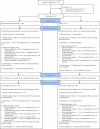The effect of dance mat exergaming systems on physical activity and health-related outcomes in secondary schools: results from a natural experiment
- PMID: 25217144
- PMCID: PMC4169828
- DOI: 10.1186/1471-2458-14-951
The effect of dance mat exergaming systems on physical activity and health-related outcomes in secondary schools: results from a natural experiment
Abstract
Background: Exergaming has been proposed as an innovative method for physical activity promotion. However, large effectiveness studies are rare. In January 2011, dance mat systems were introduced in secondary schools in two districts in England with the aim of promoting an innovative opportunity for physical activity. The aim of this natural experiment was to examine the effect of introducing the dance mat exergaming systems on physical activity and health-related outcomes in 11-13 year old students using a non-randomised controlled design and mixed methods.
Methods: Participants were recruited from five schools in intervention districts (n = 280) and two schools in neighbouring control districts (n = 217). Data on physical activity (accelerometer), anthropometrics (weight, BMI and percentage of body fat), aerobic fitness (20-m multistage shuttle run test), health-related quality of life (Kidscreen questionnaire), self-efficacy (children's physical activity self-efficacy survey), school attendance, focus groups with children and interviews with teachers were collected at baseline and approximately 12 months follow-up.
Results: There was a negative intervention effect on total physical activity (-65.4 cpm CI: -12.6 to -4.7), and light and sedentary physical activity when represented as a percentage of wear time (Light: -2.3% CI: -4.5 to 0.2; Sedentary: 3.3% CI: 0.7 to 5.9). However, compliance with accelerometers at follow-up was poor. There was a significant positive intervention effect on weight (-1.7 kg, 95% CI: -2.9 to -0.4), BMI (-0.9 kg/m2, 95% CI: -1.3 to -0.4) and percentage of body fat (-2.2%, 95% CI: -4.2 to -0.2). There was also evidence of improvement in some health-related quality of life parameters: psychological well-being (2.5, 95% CI: 0.1 to 4.8) and autonomy and parent relation (4.2, 95% CI: 1.4 to 7.0).
Conclusions: The implementation of a dance mat exergaming scheme was associated with improvement in anthropometric measurements and parameters of health-related quality of life. However, the mechanisms of these benefits are unclear as there was insufficient data from physical activity to draw robust conclusions. Qualitative findings suggest that there was declining support for the initiative over time, meaning that potential benefits may not have been achieved.
Figures
References
-
- De Bourdeaudhuij I, Van CE, Spittaels H, Oppert JM, Rostami C, Brug J, Van LF, Lobstein T, Maes L. School-based interventions promoting both physical activity and healthy eating in Europe: a systematic review within the HOPE project. Obes Rev. 2011;12:205–216. doi: 10.1111/j.1467-789X.2009.00711.x. - DOI - PubMed
-
- Dobbins M, De CK, Robeson P, Husson H, Tirilis D. School-based physical activity programs for promoting physical activity and fitness in children and adolescents aged 6–18. Cochrane Database Syst Rev. 2009;21:CD007651. - PubMed
-
- Kriemler S, Meyer U, Martin E, van Sluijs EM, Andersen LB, Martin BW. Effect of school-based interventions on physical activity and fitness in children and adolescents: a review of reviews and systematic update. Br J Sports Med. 2011;45:923–930. doi: 10.1136/bjsports-2011-090186. - DOI - PMC - PubMed
-
- Witherspoon Hansen L, Sanders S. Digit Cult Educ. 2011. Active gaming: a new paradigm in childhood physical activity.
Pre-publication history
-
- The pre-publication history for this paper can be accessed here:http://www.biomedcentral.com/1471-2458/14/951/prepub
Publication types
MeSH terms
Grants and funding
LinkOut - more resources
Full Text Sources
Other Literature Sources
Medical
Miscellaneous


